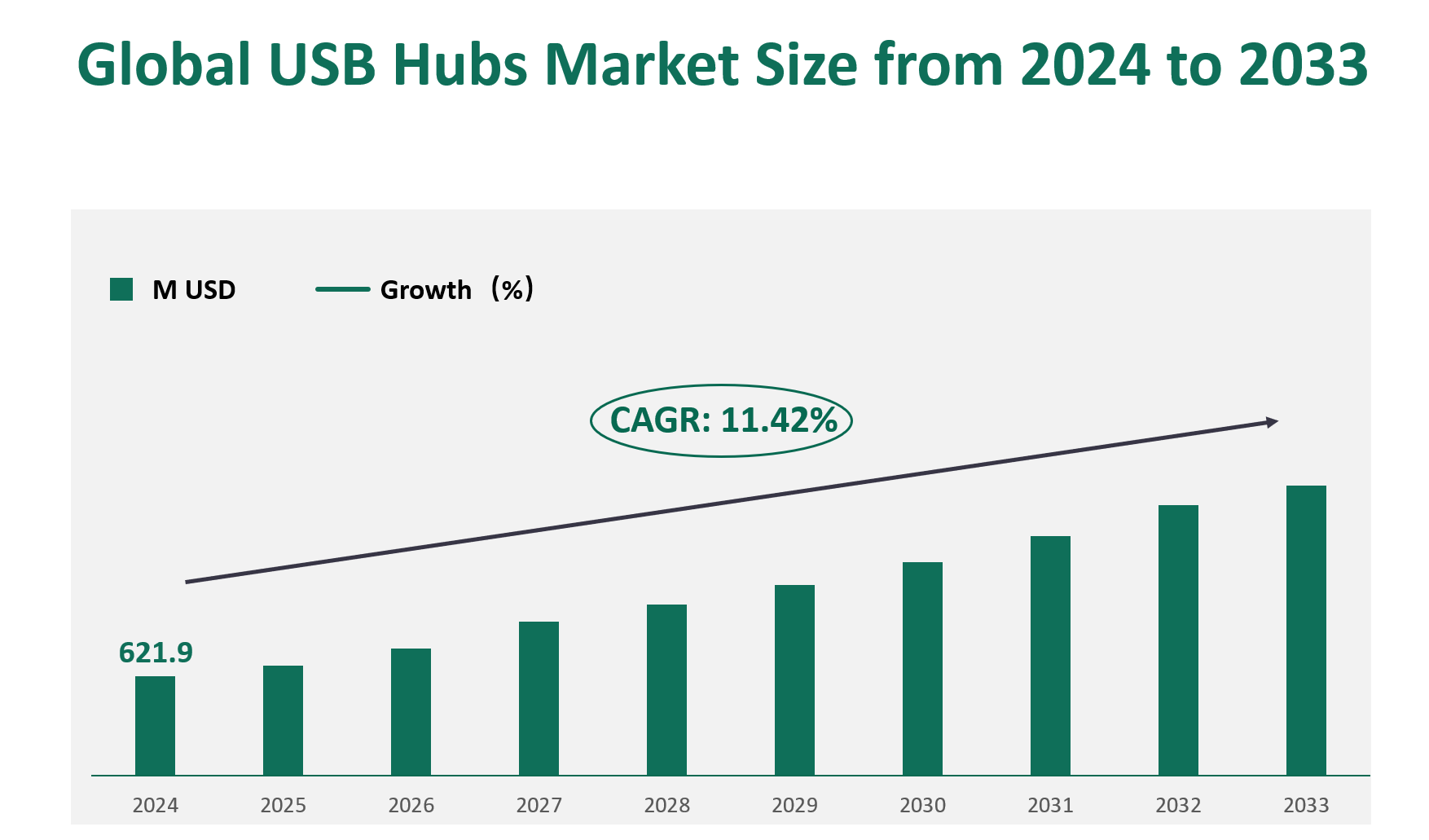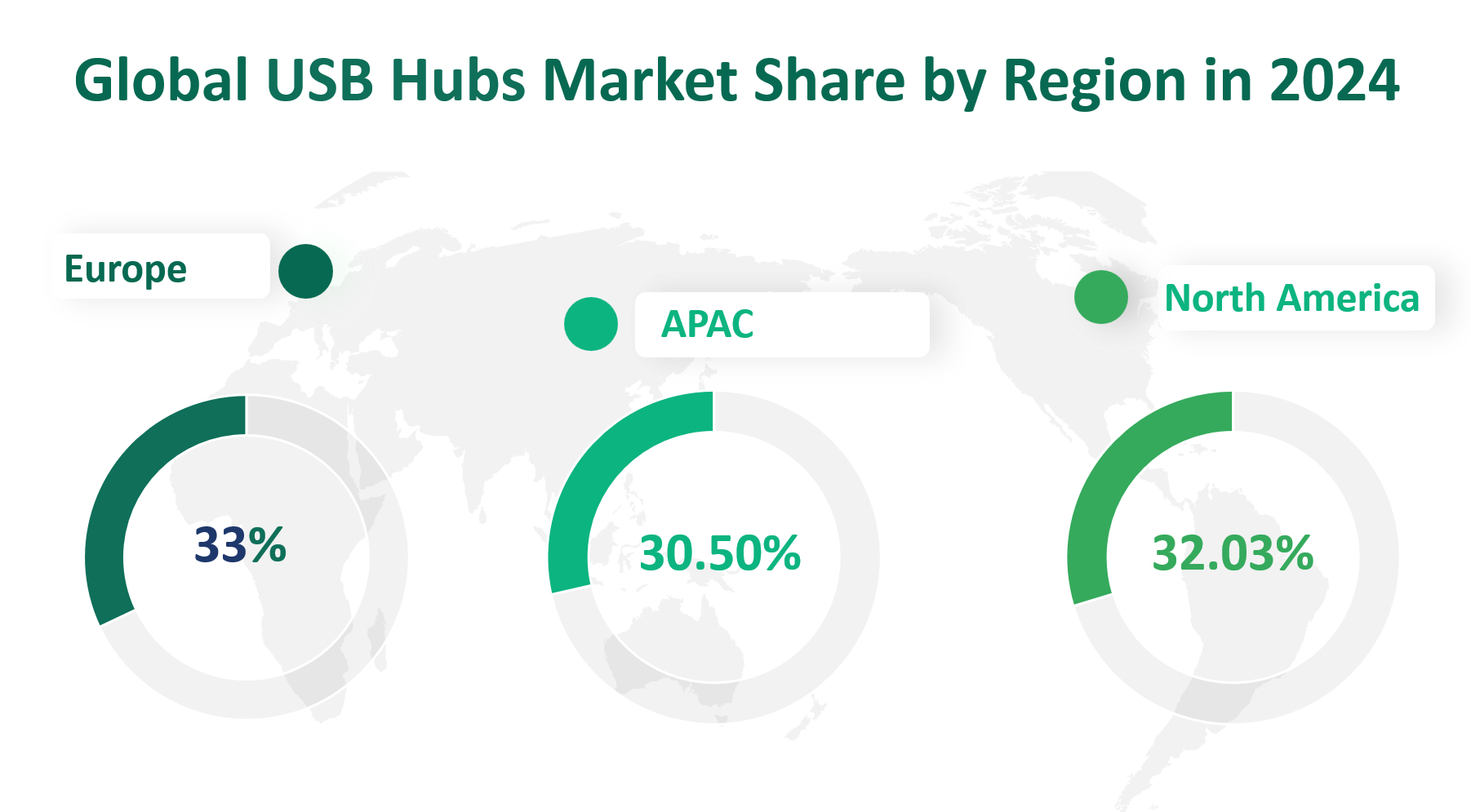1. Global USB Hubs Market Insight Analysis
In 2024, the global USB Hubs market revenue is projected to reach $621.9 million. This growth is expected to continue in the coming years, with a Compound Annual Growth Rate (CAGR) of 11.42% from 2024 to 2033.
A USB Hub, by definition, is a device that expands the number of USB ports available on a computer or other electronic device. It allows users to connect multiple USB devices such as external hard drives, flash drives, smartphones, keyboards, and mice to a single USB port. USB Hubs are essential in addressing the common issue of insufficient USB ports on modern laptops and desktop computers, especially with the increasing popularity of Ultrabooks and other thin devices that often come with limited port options.
Figure Global USB Hubs Market Size (M USD) and CAGR (2024-2033)

2. Driving and Limiting Factors of USB Hubs Market Growth
As more electronic devices require USB connections, the need for additional ports has surged. The rise in remote work and online learning has further amplified this demand, as users require more ports to connect peripherals like webcams, printers, and external storage devices.
The development of faster USB standards, such as USB 3.0 and USB 3.1, has improved data transfer speeds, making USB Hubs more appealing for high-speed data applications. This technological progress has driven market growth by offering better performance and compatibility with modern devices.
Higher disposable incomes have enabled consumers to invest in additional electronic accessories, including USB Hubs. This trend is particularly evident in emerging economies where the middle class is expanding and purchasing power is increasing.
The COVID-19 pandemic has accelerated the adoption of remote work and online learning, leading to a significant increase in the demand for USB Hubs. As more people work and study from home, the need for efficient connectivity solutions has become paramount.
The development of wireless connectivity solutions, such as Wi-Fi and Bluetooth, poses a threat to the USB Hubs market. These technologies offer the convenience of wireless connections, reducing the need for physical ports.
The market has been plagued by counterfeit and low-quality products, which can cause security issues and reduce consumer trust. This problem has persisted and continues to hinder the market’s growth.
The USB Hubs industry has relatively low technical barriers to entry, leading to an influx of low-cost, low-quality products. This saturation can lead to market fragmentation and reduced profitability for established players.
3. Technology Innovation and Corporate Mergers and Acquisitions in USB Hubs Market
The transition from USB 2.0 to USB 3.0 and beyond has been a major driver of market growth. USB 3.0 offers data transfer speeds up to 5 Gbps, a substantial improvement over the 480 Mbps of USB 2.0. The introduction of USB 3.1 further increased speeds to 10 Gbps, making USB Hubs more competitive with wireless solutions. Additionally, the development of USB Type-C connectors has enhanced the versatility and future-proofing of USB Hubs.
The market has witnessed several strategic mergers and acquisitions aimed at expanding product portfolios and strengthening market positions. For example, StarTech.com, a leading manufacturer of connectivity products, expanded into new markets such as Finland and Chile through distribution agreements with major technology distributors like Ingram Micro. This expansion strategy has helped StarTech.com solidify its global presence and increase its market share.
Companies are continuously launching new products to meet evolving consumer needs. For instance, StarTech.com introduced new USB-C hubs with advanced features such as USB 3.1 Gen 2 compatibility, providing users with faster data transfer rates and enhanced connectivity options. These product launches not only meet current market demands but also set the stage for future growth.
4. Global USB Hubs Market Size by Type
USB 2.0 hubs have been the traditional choice for many users due to their widespread compatibility and sufficient data transfer speeds for general use. In 2024, the market revenue for USB 2.0 hubs is forecasted to be 56.14 million USD. Despite their lower data transfer speeds compared to USB 3.0, USB 2.0 hubs remain popular in applications where high-speed data transfer is not critical. Their market share is declining gradually as USB 3.0 hubs become more prevalent, but they still hold a significant portion of the market due to their affordability and compatibility with older devices.
USB 3.0 hubs represent a significant upgrade in terms of data transfer speeds, offering rates up to 5Gbps, which is a substantial improvement over USB 2.0’s 480Mbps. This makes USB 3.0 hubs ideal for applications requiring high-speed data transfer, such as transferring large files or connecting high-resolution peripherals. In 2024, the market revenue for USB 3.0 hubs is projected to be 548.20 million USD.
Combined form hubs are designed to offer a blend of USB 2.0 and USB 3.0 ports, providing flexibility for users who need to connect both older and newer devices. In 2024, the market revenue for combined form hubs is forecasted to be 17.56 million USD. The growth rate of combined form hubs has been moderate, as the market gradually shifts towards USB 3.0 hubs for their superior performance.
Table Global USB Hubs Market Size by Type in 2024
5. Global USB Hubs Market Size by Application
The applications of USB Hubs can be broadly categorized into two main segments: Residential and Commercial.
The residential application segment refers to the use of USB Hubs in homes, where they are primarily used to connect multiple devices to personal computers, laptops, and other electronic devices. In 2024, the market revenue for USB Hubs in residential applications is forecasted to be 255.73 million USD.
The commercial application segment includes the use of USB Hubs in offices, industries, and other business settings. These hubs are essential for connecting multiple peripherals to workstations, servers, and other commercial-grade devices. In 2024, the market revenue for USB Hubs in commercial applications is projected to be 366.16 million USD.
Table Global USB Hubs Market Size by Application in 2024
Application | Market Size (M USD) 2024 |
Residential | 255.73 |
Commercial | 366.16 |
6. Global USB Hubs Market by Major Regions
The North American market is projected to generate a revenue of $199.18 million in 2024. This region has historically been a strong market for USB Hubs, driven by the high adoption of advanced technology and the presence of major technology hubs in the United States and Canada. The market growth in this region is supported by the increasing demand for high-speed data transfer solutions, especially in the commercial sector.
Europe is expected to contribute $205.26 million to the global USB Hubs market in 2024. Europe has been a significant market due to its robust industrial base and high demand for connectivity solutions in both residential and commercial applications. The region’s focus on innovation and technology adoption has also played a crucial role in driving market growth.
The Asia-Pacific region is anticipated to achieve a revenue of $189.70 million in 2024. This region has seen rapid growth in recent years, driven by the expanding economies of China, Japan, and South Korea. The increasing adoption of USB Hubs in both consumer electronics and industrial applications has been a key factor in the region’s market growth. Additionally, the presence of major manufacturing hubs has facilitated the production and distribution of USB Hubs.
The South American market is forecasted to generate a revenue of $15.39 million in 2024. While this region has a smaller market size compared to others, it has shown steady growth, driven by the increasing demand for connectivity solutions in Brazil and other major economies.
The Middle East and Africa region is expected to contribute $12.37 million to the global USB Hubs market in 2024. This region’s market growth is driven by the increasing adoption of technology in emerging economies and the need for connectivity solutions in both residential and commercial sectors.
Figure Global USB Hubs Market Size by Region in 2024

7. Global USB Hubs Market Analysis by Major Players
7.1 StarTech
Company Introduction and Business Overview: StarTech, founded in 1985, is a leading manufacturer of connectivity products with operations in five continents. The company is headquartered in Canada and primarily serves the North European market. StarTech specializes in providing a wide range of IT and AV connectivity solutions, including USB Hubs.
Products Offered: StarTech offers a variety of USB Hubs, including USB 3.1 Gen 2 hubs, which provide data transfer speeds up to 10 Gbps. Their products are designed to enhance connectivity options for devices with limited built-in ports.
7.2 SSK
Company Introduction and Business Overview: SSK Corporation, established in 2001, is based in China and primarily serves the APAC and European markets. The company specializes in developing and manufacturing a wide range of electronic and digital products, including USB Hubs.
Products Offered: SSK offers USB 3.0 hubs with multiple ports, designed to support high-speed data transfer and compatibility with various devices. Their hubs are known for their durability and ease of use.
7.3 UGREEN
Company Introduction and Business Overview: UGREEN, founded in 2012, is headquartered in China and primarily serves the APAC market. The company specializes in providing digital solutions and has developed a strong reputation for innovation and quality.
Products Offered: UGREEN offers a range of USB Hubs, including USB 3.0 hubs with multiple ports and advanced features such as USB-C connectivity. Their products are designed to meet the evolving needs of consumers and businesses.

